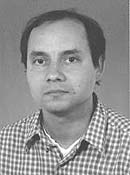Contents: 2024 | 2023 | 2022 | 2021 | 2020 | 2019 | 2018 | 2017 | 2016 | 2015 | 2014 | 2013 | 2012 | 2011 | 2010 | 2009 | 2008 | 2007 | 2006 | 2005 | 2004 | 2003 | 2002 | 2001
2007, 19
Modeling of gallium arsenide surface acoustic wave devices
language: English
received 24.01.2006, published 19.09.2007
Download article (PDF, 340 kb, ZIP), use browser command "Save Target As..."
To read this document you need Adobe Acrobat © Reader software, which is simple to use and available at no cost. Use version 4.0 or higher. You can download software from Adobe site (http://www.adobe.com/).
ABSTRACT
A Surface-Acoustic Wave (SAW) device has been modeled employing a second-order Lagrangian finite-element method. The model is able to describe SAW response variations with arbitrary orientation of the unit crystal cell as compared to the macroscopic device geometry and hence allows for fast SAW design optimization. The model is used to determine the resonance frequency of different SAW device structures. The finite-element results are compared with independent analytical results obtained for two configurations of the applied electrode voltages. In order to obtain significant excitation of SAWs, it is preferable to have the electrode fingers oriented along the [110] crystal axis direction, which is the direction along the x=y line with z constant. Indeed, characteristics of normal displacement amplitudes as a function of rotation angle between the crystal axes and the electrode fingers at a fixed frequency albeit independent of the frequency verify that strong SAW excitations take place for rotation angles near 45 degrees corresponding to the [110] direction. Computations of various eigenmodes of both Rayleigh and Lamb type are discussed.
Keywords: SAW, piezoelectric, GaAs, zincblende, rotation.
13 pages, 9 figures
Сitation: D. Bødewadt Carstensen, T. Amby Christensen, Morten Willatzen, P. V. Santos. Modeling of gallium arsenide surface acoustic wave devices. Electronic Journal “Technical Acoustics”, http://www.ejta.org, 2007, 19.
REFERENCES
1. C. C. W. Ruppel and T. A. Fjeldly. Advances in Surface Acoustic Wave Technology, Systems and Applications-1. Selected Topics in Electronics and Systems, World Scientific, 19 (2000).
2. C. K. Campbell. Surface Acoustic Wave Devices for Mobile and Wireless Communications. Applications of Modern Acoustics, Academic Press (1998).
3. M. J. Hoskins, H. Morkoç and B. J. Hunsinger. Surface acoustic wave on the (112) cut [110] direction of gallium arsenide. Appl. Phys. Lett., 41, 332 (1982).
4. C. Rocke, S. Zimmermann, A. Wixforth, J. P. Kotthaus, G. Böhm and G. Weimann. Acoustically Driven Storage of Light in a Quantum Well. Phys. Rev. Lett., 78, 4099 (1997).
5. P. V. Santos. Collinear light modulation by surface acoustic waves in laterally structured semiconductors. Journal of Applied Physic, 89, 5060 (2001).
6. M. M. de Lima, Jr., R. Hey and P. V. Santos. Appl. Phys. Lett., 83, 2997 (2003).
7. F. W. Beil, A. Wixforth and R. H. Blick. Active photonic crystals based on surface acoustic waves. Physica E (Amsterdam), 13, 473 (2002).
8. Y. Takagaki, E. Wiebicke, P. V. Santos, R. Hey and K. H. Ploog. Propagation of surface acoustic waves in a GaAs/AlAs/GaAs heterostructure and micro-beams. Semicond. Sci. Technol., 17, 1008 (2002).
9. A. Gantner, Mathematical modeling and numerical simulation of piezoelectrical agitated surface acoustic waves. Ph.D. Thesis. Faculty of Mathematics and Natural Sciences, University of Augsburg, Germany (2005).
10. B. A. Auld. Acoustic Fields and Waves in Solids, vol. 1 and 2, 2nd edition. Krieger Publishing Company (1990).
11. M. Willatzen. Ultrasound transducer modeling - general theory and applications to ultrasound reciprocal systems. IEEE Transactions on Ultrasonics, Ferroelectrics, and Frequency Control, 48, 100-112 (2001).
12. M. M. de Lima, Jr., W. Seidel, H. Kostial and P. V. Santos. Embedded interdigital transducers for high-frequency surface acoustic waves on GaAs. Journal of Applied Physic, 96, 3494-3500 (2004).
13. M. M. de Lima, Jr., W. Seidel, F. Alsina and P. V. Santos. Focusing of surface-acoustic-wave fields on [100] GaAs surfaces. Journal of Applied Physics. 94, 7848-7855 (2003).
 |
Dennis Bødewadt Carstensen received his M.Sc. degree in Mechatronic Engineering at the University of Southern Denmark in 2006 after finishing his thesis on "Modelling of Piezoelectric Effects in Solid Crystals and Applications to Surface Acoustic Wave Devices". He is currently employed as a Research & Development Engineer at Danfoss A/S in the subdivision Danfoss Electronic Controls & Sensors. E-mail: d_carstensen(at)danfoss.com |
|
 |
Torben Amby Christensen received his M.Sc. degree in Mechatronic Engineering at the University of Southern Denmark in 2005 after finishing his thesis on "Multiphysics Mathematical Modelling of Piezoelectric Transducers". He is currently pursuing the Ph.D degree in "Advanced Techniques in Electromagnetic Flow-measurement" at the University of Southern Denmark, in collaboration with Siemens Flow Instruments. E-mail: torben-amby.christensen(at)siemens.com |
|
 |
Morten Willatzen is a Professor, Ph.D., at the Mads Clausen Institute for Product Innovation, University of Southern Denmark. His research interests are ultrasonics, piezoelectrics, and semiconductor electronic band-structures. E-mail: willatzen(at)mci.sdu.dk |
|
 |
Paulo V. Santos is a Senior Scientist at the Paul Drude Institute for Solid State Electronics in Berlin. He has a Ph.D. degree in Solid State Physics and is an expert in the physics of surface acoustic wave devices. E-mail: santos(at)pdi-berlin.de |
|
